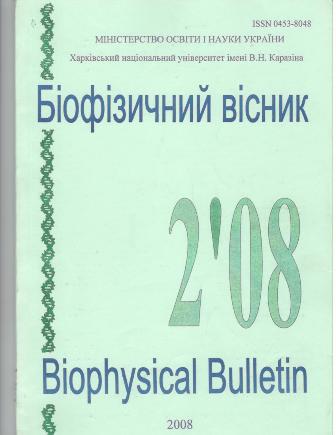A change in the mobility of membrane lipids affects the interaction of gramicidin s with human erythrocytes
Abstract
Gramicidin S interacts unspecifically with the lipid bilayer of the membrane of different cells and can disrupt the structure of not only erythrocyte membrane, but other blood cells as well and cause a change in their functional activity during the system application of the drug. The study of the interaction of membranotropic antimicrobial drugs with blood cell membranes makes it possible to explain the possible ways of increasing their therapeutic index. A change of the state of lipid bilayer affects GS interaction with membrane. Study of the interaction of gramicidin S with the cell membranes, modified by different physical and chemical factors, will make it possible to establish the mechanism of interaction in more detail and to determine the directions of the modification of the molecule of gramicidin S for the purpose of reduction in its hemolytic activity without loss of its antimicrobial effect. In the present paper with the help of the turbidimetry technique, the hemolysis of human erythrocytes under the action of gramicidin S in the presence of the different membrane modifiers was studied. It was shown that the character of the gramicidin binding to membranes depends on temperature - with an increase in the temperature from 22 to 40°С the concentration of gramicidin capable of causing the hemolysis of erythrocytes decreases. It was established that the decrease of the ordering of lipids in the erythrocyte membrane caused by lipid peroxidation in vitro facilitates the incorporation of gramicidin into the membrane, but, at the same time, it leads also to the decrease of the strength of gramicidin binding with the membranes. It was proven that the modification of the state of a membrane lipid bilayer with the peroxidation changes the hemolytic activity of gramicidin S. It was shown that there is a possibility of the directed modification of the membrane structure for increasing their resistance to the lytic action of gramicidin S.
Downloads
References
Microbiology Reviews. – 2006. - Vol. 19, No. 3. - P. 491–511.
2. Hancock R.E., Sahl H.G. Antimicrobial and host-defense peptides as new anti-infective
therapeutic strategies // Nat. Biotechnol. – 2006. – V. 24, N 12. – P. 1551-1557
3. Yamada K., Shinoda S.S., Oku H., Komagoe K., Katsu T., Katakai R. Synthesis of lowhemolytic antimicrobial dehydropeptides based on gramicidin s // J. Med. Chem. – 2006.
– V. 49, N 26. – P. 7592-7595.
4. Abraham T., Marwaha S., Kobewka D.M. et al. The relationship between the binding to and permeabilization of phospholipid bilayer membranes by GS14dK4, a designed analog
of the antimicrobial peptide gramicidin S // Biochim. Biophys. Acta. – 2007. – V. 1768, N9. – P. 2089-2098.
5. Хакл Е.В., Берест В.П., Гаташ С.В. Влияние гамма-облучения на агрегацию тромбоцитов // Вісн. Харк. ун-ту. - 1998. - № 450. - Біофізичний вісн. - Вип.4. - С.96-99
6. Адиб Халаф Фадел Аль Амуш, Берест В.П., Хакл Е.В. Активация и дезагрегация тромбоцитов in vitro при действии грамицидина S // Вісник проблем біології і
медицини. – 2007. – Вип. 1. – С. 167-172.
7. Хакл Е.В., Берест В.П., Гаташ С.В. Устойчивость эритроцитов человека к гемолизу под действием полипептидного антибиотика грамицидина S // Біофізичний вісник. -
2008. - № 20(1).- 114-120.
8. Биофизика клеточных популяций и надорганизменных систем: Сб.науч.тр. / Отв.ред.И.И. Гительзон. - Новосибирск: Наука, СО, 1992. - 159 с.
9. Берест В.П., Гаташ С.В. Залежність агрегації тромбоцитів від температури //
Фізіологічний журнал. - 1998. - Т.44, №5-6. - С.89-94.
10. Досон Р., Эллиот Д., Эллиот У. и др. Справочник биохимика. - М.: Мир, 1991. – 544 с.
11. Владимиров Ю.А., Арчаков А.И. Перекисное окисление липидов в биологических мембранах. - М.: Наука, 1972. - 252 с. 63
Изменение подвижности липидов мембраны влияет на взаимодействие…
12. Atkins P.W. Physical Chemistry. Fifth eddition, Oxford, Melbourne, Tokyo. Oxford
University Press, 1994. - 1031 p.
13. Ивков В.Г., Берестовский Г.Н. Динамическая структура липидного бислоя. - М.:
Наука, 1981. - 293 с.
14. Hackl EV, Gatash SV, Nikolov OT. Using UHF-dielectrometry to study protein structural
transitions // J. Biochem. Biophys. Methods. – 2005. – V.63, N 2. – P. 137-148.
15. Hackl E., Berest V., Alamoush A., Gatash S. Gramicidin S effect on human blood
platelets depends on the mobility of membrane lipids // Journal of Peptide Science. –
2006. - Volume 12, Issue S1. – P. 227.
16. Przybylska M., Bryszewska M., Chapman I.V. Thermal properties and fluidity of human erythrocyte membranes in diabetes mellitus // Int. J. Radiat. Biol. – 1993. – V. 63, N 3. –
P. 419-424.
17. Przybylska M., Bryszewska M., Kedziora J. Thermosensitivity of red blood cells from Down's syndrome individuals // Bioelectrochemistry. – 2000. – V. 52, N 2. - P. 239-249.
18. Leyko W., Bartosz G. Membrane Effects of ionizing radiation and hyperthermia //International Journal of Radiation Biology. – 1985. – Vol. 49, Issue 5. – P. 743–770.
19. Watanabe H., Kobayashi A., Yamamoto T., et. al. Alterations of human erythrocytes membrane fluidity by oxygen-derived free radicals and calcium // Free Radic. Biol. Med.
– 1990. - 8 (6). – P. 507-514.
Authors who publish with this journal agree to the following terms:
- Authors retain copyright and grant the journal right of first publication with the work simultaneously licensed under a Creative Commons Attribution License that allows others to share the work with an acknowledgement of the work's authorship and initial publication in this journal.
- Authors are able to enter into separate, additional contractual arrangements for the non-exclusive distribution of the journal's published version of the work (e.g., post it to an institutional repository or publish it in a book), with an acknowledgement of its initial publication in this journal.
- Authors are permitted and encouraged to post their work online (e.g., in institutional repositories or on their website) prior to and during the submission process, as it can lead to productive exchanges, as well as earlier and greater citation of published work (See The Effect of Open Access).





